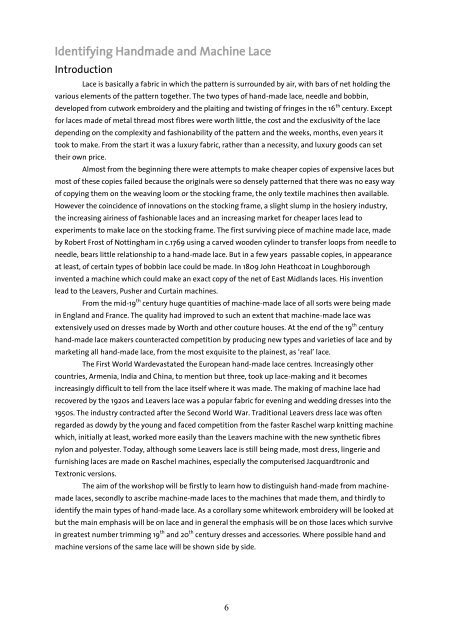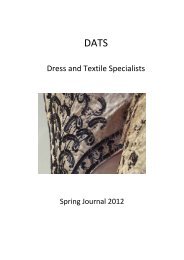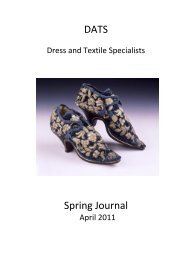Identifying Handmade and Machine Lace - Dress and Textile ...
Identifying Handmade and Machine Lace - Dress and Textile ...
Identifying Handmade and Machine Lace - Dress and Textile ...
Create successful ePaper yourself
Turn your PDF publications into a flip-book with our unique Google optimized e-Paper software.
<strong>Identifying</strong> <strong>H<strong>and</strong>made</strong> <strong>and</strong> <strong>Machine</strong> <strong>Lace</strong><br />
Introduction<br />
<strong>Lace</strong> is basically a fabric in which the pattern is surrounded by air, with bars of net holding the<br />
various elements of the pattern together. The two types of h<strong>and</strong>-made lace, needle <strong>and</strong> bobbin,<br />
developed from cutwork embroidery <strong>and</strong> the plaiting <strong>and</strong> twisting of fringes in the 16 th century. Except<br />
for laces made of metal thread most fibres were worth little, the cost <strong>and</strong> the exclusivity of the lace<br />
depending on the complexity <strong>and</strong> fashionability of the pattern <strong>and</strong> the weeks, months, even years it<br />
took to make. From the start it was a luxury fabric, rather than a necessity, <strong>and</strong> luxury goods can set<br />
their own price.<br />
Almost from the beginning there were attempts to make cheaper copies of expensive laces but<br />
most of these copies failed because the originals were so densely patterned that there was no easy way<br />
of copying them on the weaving loom or the stocking frame, the only textile machines then available.<br />
However the coincidence of innovations on the stocking frame, a slight slump in the hosiery industry,<br />
the increasing airiness of fashionable laces <strong>and</strong> an increasing market for cheaper laces lead to<br />
experiments to make lace on the stocking frame. The first surviving piece of machine made lace, made<br />
by Robert Frost of Nottingham in c.1769 using a carved wooden cylinder to transfer loops from needle to<br />
needle, bears little relationship to a h<strong>and</strong>-made lace. But in a few years passable copies, in appearance<br />
at least, of certain types of bobbin lace could be made. In 1809 John Heathcoat in Loughborough<br />
invented a machine which could make an exact copy of the net of East Midl<strong>and</strong>s laces. His invention<br />
lead to the Leavers, Pusher <strong>and</strong> Curtain machines.<br />
From the mid-19 th century huge quantities of machine-made lace of all sorts were being made<br />
in Engl<strong>and</strong> <strong>and</strong> France. The quality had improved to such an extent that machine-made lace was<br />
extensively used on dresses made by Worth <strong>and</strong> other couture houses. At the end of the 19 th century<br />
h<strong>and</strong>-made lace makers counteracted competition by producing new types <strong>and</strong> varieties of lace <strong>and</strong> by<br />
marketing all h<strong>and</strong>-made lace, from the most exquisite to the plainest, as „real‟ lace.<br />
The First World Wardevastated the European h<strong>and</strong>-made lace centres. Increasingly other<br />
countries, Armenia, India <strong>and</strong> China, to mention but three, took up lace-making <strong>and</strong> it becomes<br />
increasingly difficult to tell from the lace itself where it was made. The making of machine lace had<br />
recovered by the 1920s <strong>and</strong> Leavers lace was a popular fabric for evening <strong>and</strong> wedding dresses into the<br />
1950s. The industry contracted after the Second World War. Traditional Leavers dress lace was often<br />
regarded as dowdy by the young <strong>and</strong> faced competition from the faster Raschel warp knitting machine<br />
which, initially at least, worked more easily than the Leavers machine with the new synthetic fibres<br />
nylon <strong>and</strong> polyester. Today, although some Leavers lace is still being made, most dress, lingerie <strong>and</strong><br />
furnishing laces are made on Raschel machines, especially the computerised Jacquardtronic <strong>and</strong><br />
Textronic versions.<br />
The aim of the workshop will be firstly to learn how to distinguish h<strong>and</strong>-made from machine-<br />
made laces, secondly to ascribe machine-made laces to the machines that made them, <strong>and</strong> thirdly to<br />
identify the main types of h<strong>and</strong>-made lace. As a corollary some whitework embroidery will be looked at<br />
but the main emphasis will be on lace <strong>and</strong> in general the emphasis will be on those laces which survive<br />
in greatest number trimming 19 th <strong>and</strong> 20 th century dresses <strong>and</strong> accessories. Where possible h<strong>and</strong> <strong>and</strong><br />
machine versions of the same lace will be shown side by side.<br />
6





